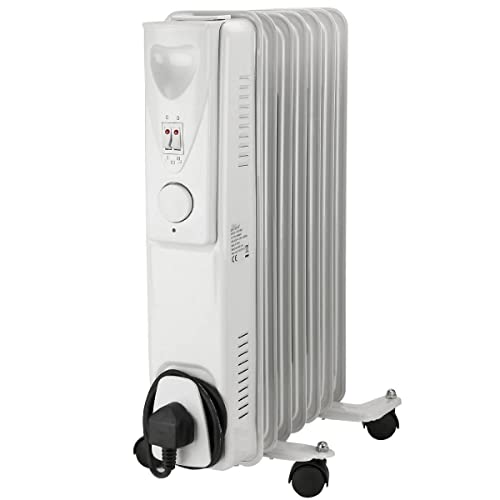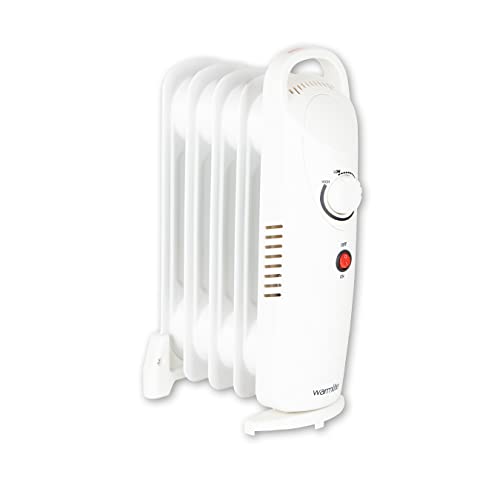Discussion Board
About Me
 Oil Radiator Small Electric Heater
Oil Radiator Small Electric Heater
 Oil-filled radiators consume less energy despite having a lower power consumption. This is due to the diathermic oils they utilize are hot and retain heat longer.
Oil-filled radiators consume less energy despite having a lower power consumption. This is due to the diathermic oils they utilize are hot and retain heat longer.
The De'Longhi TRNS0505M uses just 500W at its most powerful setting, which means it can be one of the most energy efficient heaters designed for small spaces. It also has an easy to use thermostat dial that can be an absolute blessing for anyone who has issues with mobility or vision.
Product Description
Oil radiators are portable heaters that connect to electricity used in homes via an ordinary plug. They operate by heating a reservoir of thermal oil filled radiator mini, which in turn warms the air in the room. The majority of them have a thermostat which can be set at a desired temperature. Some even have a remote control.
The electrical component of an oil-filled heater is a coil comprised of metal resistive wire. When it is turned on, electrons whirl around in the coil and generate heat, which warms the oil. The heat generated by the oil then warms the air, creating a pleasant microclimate in the room.
Oil-filled radiators are more efficient than baseboards because they only consume energy to heat the oil filled wall mounted radiator, not the air. They also tend to be quieter, making them ideal for bedrooms and offices.
Product Features
A small electric oil heater is a great method to heat the room. They connect to household electricity via an ordinary wall plug and offer quiet operation. They are simple to use, using simple digital controls, adjustable thermostats and programmable timers. They are equipped with advanced safety features like overheat protection and tip-over buttons. The oil in the radiator is sealed for life and doesn't need to be replaced.
Convection transfers heat from oil to a room via an electric heating element at the bottom of the heater. This makes the radiator a highly efficient home heating system because it doesn't burn fuel or release harmful gases. The heating elements can vary between manufacturers, but they are all made from a metal resistive wire, which is inserted into the base.
The new Rointe D Series WiFi electric radiator is equipped with intelligent energy management technology that allows you to manage your room's temperature and energy usage from your smartphone or tablet. It also works with Amazon Alexa for a seamless and hassle-free experience. Other innovative features include a 24-hour Dimplex 2kW Radiator: Timer LCD Screen Thermostat, www.fireplacesandstove.com, front dissipation wing optimization for natural air convection, as well as low-consumption technology using SMD electronic components.
With a variety of colors and finishes, you'll be able to find the perfect one for your home. This selection of electric oil-filled radiators are also ideal for use at offices and workshops where the quiet levels let you concentrate and work uninterrupted.
Product Specifications
Oil-filled Radiators are portable electric heaters that heat rooms with an internal reservoir of thermal oils. Oil-filled radiators are electric portable heating appliances that heat rooms through an internal reservoir of thermal oil. The oil in the radiator never needs refilling and isn't burned, making it an energy efficient solution for home use.
The heaters are available in freestanding and wall-mounted models. They plug into electricity used by the household. These heaters are also an energy-efficient alternative to central heating systems since they consume less energy. These radiators are usually measured in kilowatt hours (kWh). You can estimate how much energy is consumed by a radiator by multiplying its power rating by its number of hours used each day.
The heater is equipped with an integrated thermostat, a mechanical control and protection against overheating to ensure that it shuts down immediately when the temperature inside the heater is too hot. The heater is easy to move and keep in storage when not in use due to a handle for carrying, castors, and cord storage.
Unlike central heating systems, oil-filled radiators don't have any exposed heating elements, making them a more secure option for your home. If the radiator is leaking oil, it's vital to speak with a professional to refill the appliance as this is not something you can perform yourself. Leaks of oil can be hazardous since it exposes your heating element to air and can cause a fire.
Product Warranty
If a radiator is damaged it can trigger many issues in a vehicle. It is important that consumers understand how a radiator works and how it can affect its durability. This knowledge will help motorists make better decisions regarding their maintenance requirements and repair costs.
The radiator is a complicated component that needs regular maintenance in order to function properly. A radiator failure can cause coolant leaks that can harm other components in the cooling system, or cause engine problems. The performance of the radiator can also be affected by physical damage, thermostat issues and rust, or the accumulation of sediment.
Consumers can also purchase extended warranties that cover their radiators beyond the manufacturer's warranty period. These warranties often include specific terms and conditions that can vary by provider. It is crucial that consumers carefully go over the terms and conditions of the extended warranty to ensure that they receive the coverage they require.
The design of a radiator's construction may affect its durability and vulnerability to damage. Different materials have different resistance to heat, some of which are more durable than others. Consumers can research the type of radiator they're thinking of to determine which material is ideal for their specific needs.
For many warranties, including those offered by manufacturers regular inspections are required to ensure eligibility. If these guidelines are not followed, the warranty may be voided. It is important that consumers understand their warranty terms and condition.
If a radiator becomes damaged or is not working, the owner can contact their manufacturer or retailer for assistance. In most instances, the serial number of the item and proof of purchase are required to get service or an exchange. Keep the original packaging in case you have to return the appliance.
It's not common for an oil-filled heater to require refilling. If this occurs it should be handled only by a professional. It's not simple to fill an oil-filled radiator. It can be dangerous. In addition, different manufacturers use their own proprietary fluid solutions and fill levels, which makes it impossible for the average person to determine the amount of fluid to add.
Location
Occupation
Latest Post: Kamagra vs Viagra, any experience? Our newest member: violascaddan519 Recent Posts Unread Posts Tags
Forum Icons: Forum contains no unread posts Forum contains unread posts
Topic Icons: Not Replied Replied Active Hot Sticky Unapproved Solved Private Closed

